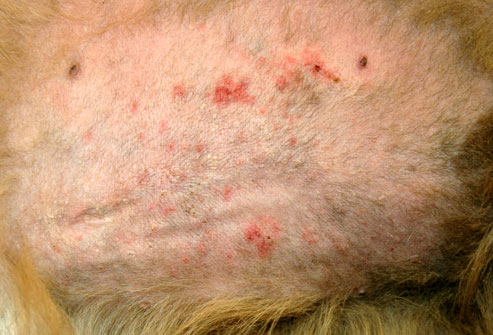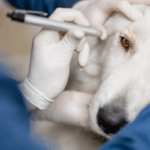What is “Allergic Skin Disease”?
Allergic skin disease involves an allergic reaction in the skin that causes intense itchiness & resultant self-trauma. The pet will scratch, bite, lick, chew or rub at the affected area causing hair loss & skin damage. The allergic reaction can be caused by many everyday common substances such as flea bites, pollens, dust mites, plants and food. There is an inherited tendency for the development of allergic skin disease; thus certain families or breeds of dog may be prone to developing allergic dermatitis. Unlike dogs, allergies in people usually involve the respiratory system causing hay fever & asthma.
Is there more than one type of Allergic Dermatitis?
1) Flea Allergy
Flea allergic pets develop sensitivity to the flea saliva, which is injected into the skin when the flea bites. The skin around the tail base & rump is most commonly affected, with hair loss & inflammation caused by the pet chewing or licking at the area. If an animal is allergic to flea saliva just one fleabite can initiate an itch-scratch cycle that can lead to significant skin damage.
2) Atopy (allergy to air-born allergens)
Some pets are allergic to allergens that are inhaled such as pollens, dust mites, moulds, wool & feathers. The symptoms may be seasonal (eg. Pollens) or year-round (eg.dust-mites). The signs usually begin around 1 to 3 years of age & often involve the skin of the face, ears, feet, armpits & abdomen.
3) Contact Allergy
The inflammation in these cases is usually seen in the areas where the body contacts the allergen, e.g. under the abdomen & inside the legs. Common allergens involved in contact dermatitis include wandering jew, ivy & carpets. It usually takes several years to develop sensitivity to contact allergens & often more than one allergen is involved.
4) Food Allergy
Some pets are allergic to particular dietary proteins, e.g. beef, fish, wheat, eggs, dairy products or soy products. The development of these allergies happens after months to years of exposure to the particular food & is not a reaction to new foods in the diet.
DIAGNOSIS
Flea allergy dermatitis
Flea Allergy Dermatitis can be diagnosed by the proper use of effective flea treatments over a 4 to 6 week period. A significant improvement over this time indicates flea allergy is the primary problem. Fleabite trials are essential as fleas are a common cause of allergic dermatitis. It is often difficult to find fleas on a flea-allergic animal because the pet swallows the fleas as it licks & bites at its skin. Many animals are persistently bothered by fleas that originate from other pets! Treatment for flea-allergy dermatitis involves the instigation of a complete flea control program.
Atopy
Atopy is a clinical diagnosis made by the veterinarian. A careful history and the strategic elimination of other causes of skin disease support the diagnosis. At this point diagnosis can be confirmed by a blood test taken at the clinic or by intradermal skin testing done by a specialist veterinary dermatologist.
Contact Allergies
Contact Allergies can be diagnosed by patch testing performed by a veterinary dermatologist. Once the offending allergen has been identified attempts can be made to avoid it.
Food Allergies
Food Allergies can be diagnosed by the use of an elimination diet. This involves choosing a food that your pet has NOT been previously exposed to & feeding only this diet for a period of up to 12 weeks. If an improvement in the itch is noticed then a challenge with your pet’s old diet will confirm food allergy. Once the offending foods have been identified a diet can be formulated to avoid them.
If your pet suffers from the itches and scratches, but you are unsure why, call us today on 9878 3033 for an appointment.






